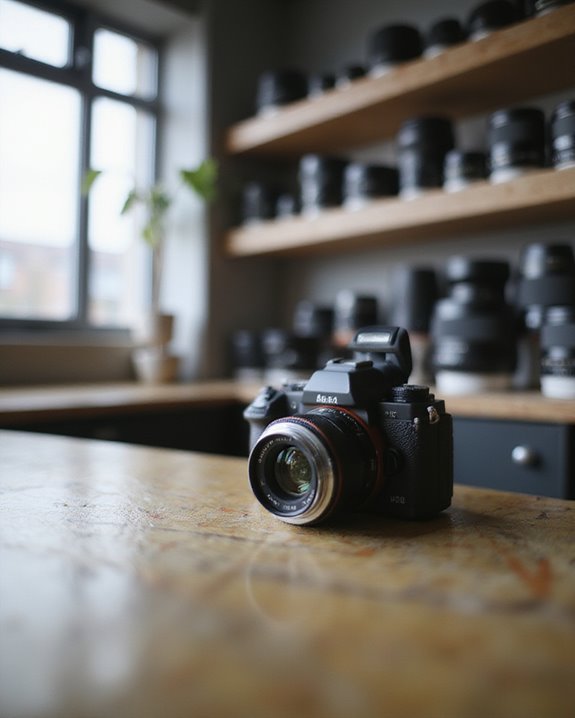Camera lenses can be purchased from various retailers including specialized photography stores (B&H Photo, Adorama), electronics chains (Best Buy), online marketplaces (Amazon), and used equipment dealers (KEH, MPB). Online platforms typically offer competitive pricing and extensive selection, while physical stores provide hands-on testing opportunities and expert advice. Prices range from under $300 for entry-level options to over $10,000 for professional-grade telephotos. Considering warranty coverage, seasonal sales, and trade-in programs can greatly enhance the value of lens investments.
Key Takeaways
- Major online retailers like Amazon, B&H Photo Video, and Adorama offer extensive lens selections, reviews, and competitive pricing.
- Specialty camera stores such as MPB and KEH provide quality-graded used lenses with warranties and rigorous testing procedures.
- Physical camera shops allow hands-on testing of lenses before purchase and offer personalized expert advice from staff.
- Online marketplaces feature comparison tools, detailed condition ratings, and often lower prices due to reduced overhead costs.
- Trade-in programs at retailers like Adorama, B&H, and KEH let photographers exchange old equipment toward new lens purchases.
Where To Buy Camera Lenses
When searching for camera lenses, photographers have numerous purchasing options available, each with distinct advantages for different needs and preferences. The marketplace spans from specialty retailers like MPB and KEH Camera, which offer quality-graded used lenses with warranties, to physical camera stores allowing hands-on inspection before purchase. Global Markets have expanded lens accessibility, with certified refurbished options from manufacturers providing middle-ground reliability between new and used equipment. Comprehensive warranties are often available through professional stores, offering peace of mind for high-end lens investments. Online platforms such as Adorama and The Camera Exchange feature extensive inventories with detailed condition ratings, while marketplaces and auctions present opportunities for finding rare or vintage optics. Trade Shows represent another avenue where photographers can examine various lenses directly and potentially negotiate competitive pricing. Each purchasing channel offers different balances of price, reliability, selection, and buyer protection, catering to diverse photography needs and investment levels.
Top Retailers for New Camera Lenses

For photographers seeking to purchase new camera lenses, several leading retailers stand out for their extensive selections, competitive pricing, and customer service. Best Buy offers in-store pickup options and low everyday prices, complemented by their user-friendly retailer apps that facilitate easy browsing and purchasing. Adorama and B&H provide thorough customer service with detailed product information, expert advice, and various payment methods including installment plans for high-end lenses. Additionally, many of these retailers carry popular lens models from top brands like Canon, Nikon, Sony, and Sigma, ensuring that photographers can find the right lens for their needs. Amazon continues to dominate the online space with fast shipping options, competitive pricing, and detailed customer reviews on products from Canon, Sony, and other major brands. Mike’s Camera distinguishes itself through localized customer service and expert guidance, particularly valuable for photographers investing in specialized equipment like macro or anamorphic lenses. Each retailer offers distinct advantages depending on customer priorities regarding inventory, expertise, and convenience.
Best Places to Find Used Camera Lenses
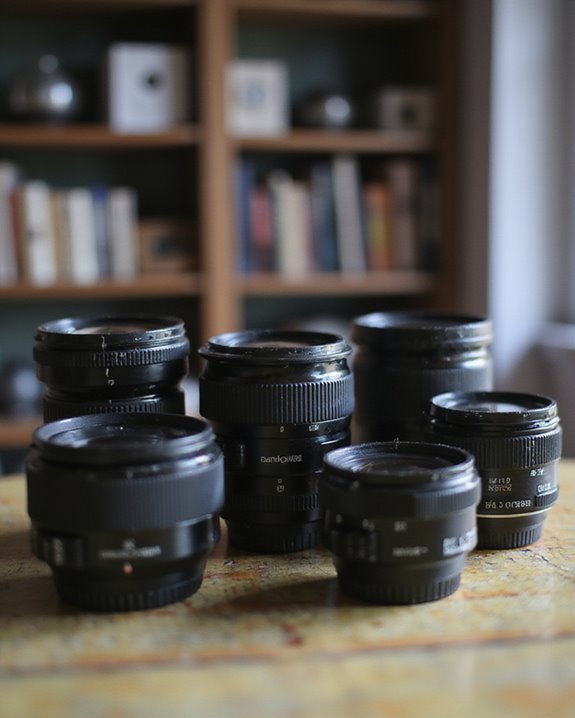
The secondary market for camera lenses offers photographers significant opportunities to acquire quality equipment at reduced prices, often making previously unaffordable glass accessible to enthusiasts on limited budgets. Specialized platforms like KEH Camera and MPB have established themselves as leaders in ethical sourcing of pre-owned equipment, implementing rigorous quality control systems and transparent grading standards. Additionally, understanding the importance of used lens quality can help buyers make more informed decisions and ensure long-term satisfaction.
Photographers seeking used lenses can explore marketplace options ranging from curated sites like Adorama and B&H Photo Video to community-based platforms such as Fred Miranda Forums and DP Review. The sustainability impact of purchasing pre-owned equipment remains significant, extending the lifecycle of precision optics while reducing manufacturing demands. When exploring these marketplaces, buyers should carefully consider lens condition, seller reputation, return policies, and payment security to guarantee a satisfactory transaction.
Understanding Price Ranges Across Lens Categories
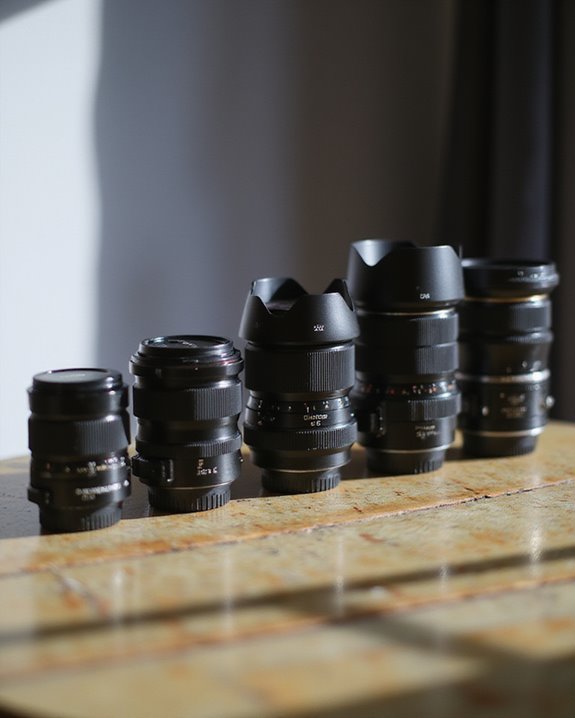
Shifting from pre-owned equipment marketplaces to new lens pricing structures helps photographers make informed purchasing decisions, regardless of whether they choose the used or new route. Lens Pricing varies substantially across different categories, with budget-friendly options starting below $300 for entry-level zooms and manual focus lenses, while specialized supertelephoto models can exceed $12,000.
Category Affordability follows predictable patterns, with prime lenses typically offering better value at lower price points ($200-$1,000 for mid-range options), while professional zooms command premium prices. The Canon RF 100-300mm F2.8 L IS USM ($9,499) and Nikon NIKKOR Z 400mm F2.8 TC VR S ($12,999.95) represent the upper echelon of telephoto investments. Specialty optics like tilt-shift and macro lenses occupy the middle ground, generally ranging from $500 to $2,000 depending on their technical specifications and brand reputation.
Online vs. Physical Camera Stores: Pros and Cons
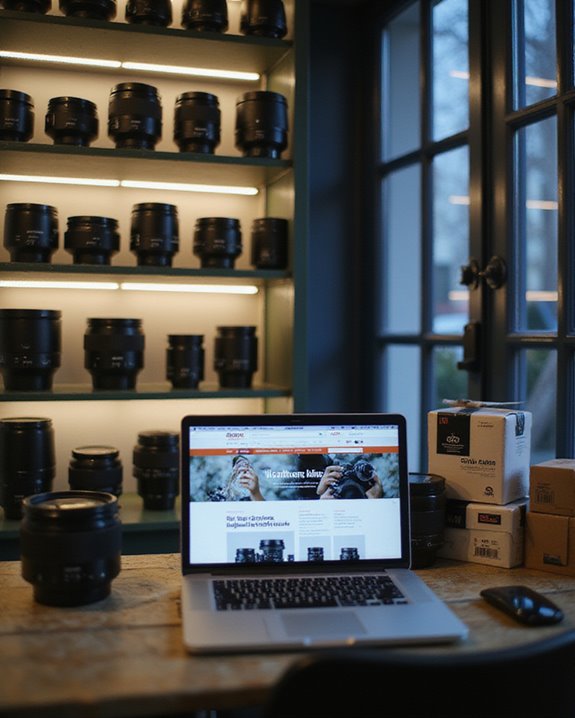
When deciding where to purchase camera lenses, photographers must carefully weigh the distinctive advantages and disadvantages of both online retailers and brick-and-mortar camera stores. Physical stores offer immediate hands-on testing opportunities and personalized support, allowing customers to assess lens ergonomics and receive real-time advice during event hosting or technical demonstrations. Online retailers typically feature lower pricing due to reduced overhead costs, alongside intuitive interface design that facilitates product comparisons and access to extensive inventory selections.
Local stores provide tangible benefits through direct customer service, acting as manufacturer advocates during warranty claims, while their online counterparts excel in convenience and accessibility. The decision ultimately depends on prioritizing immediate tactile experience and in-person support versus competitive pricing and broader selection options that online platforms consistently deliver.
How to Evaluate Lens Condition When Buying Used
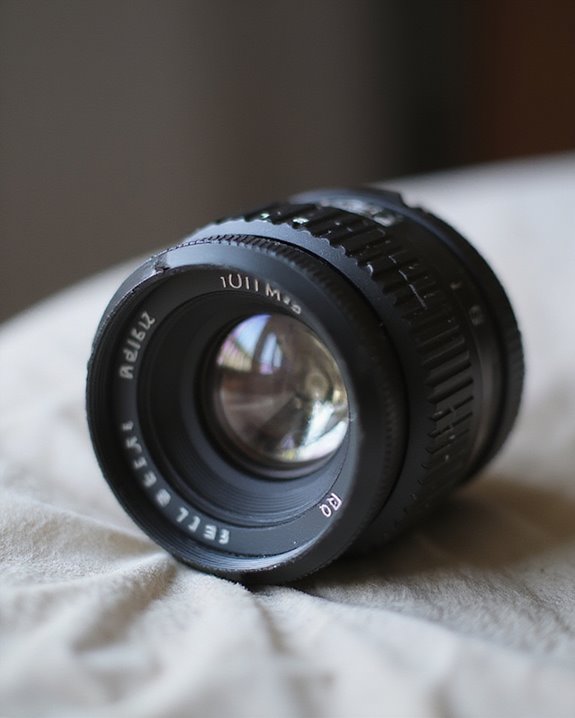
Carefully evaluating a used camera lens before purchase can mean the difference between acquiring a valuable photographic tool and investing in an expensive disappointment. Thorough Lens Evaluation requires systematic examination of both physical and optical components to verify proper functionality.
Begin with exterior inspection, checking for structural damage while verifying smooth operation of focus and zoom rings. Condition Assessment should include optical testing for sharpness, distortion, and chromatic aberration by shooting test images at various apertures and focal lengths. Examine the glass elements by shining a flashlight through the lens to reveal potential fungus or internal debris. Mechanical function tests should verify autofocus accuracy, image stabilization effectiveness, and aperture blade operation. When negotiating price, consider any detected issues against current market values for comparable equipment in similar condition.
Major Brands and Their Distribution Channels
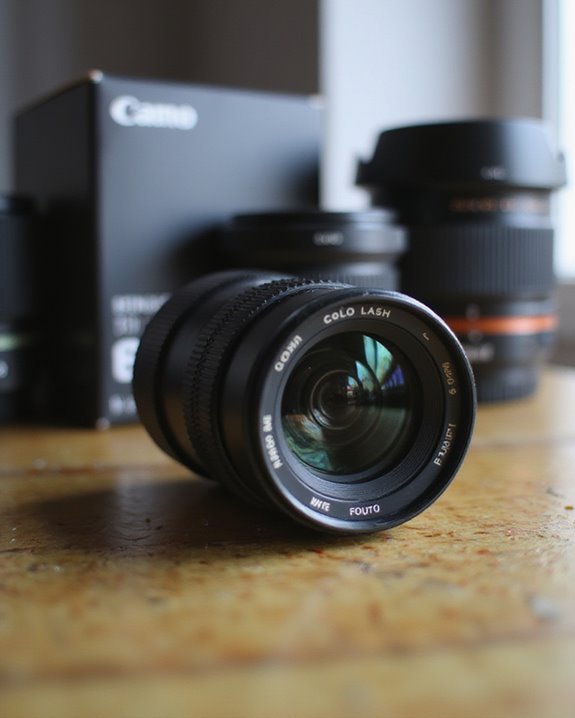
The modern landscape of camera lens acquisition spans multiple manufacturers and retail channels, each offering distinct advantages for photographers seeking to expand their optical arsenal. Brand Alliances between manufacturers and retailers shape how consumers access these precision optics, with each major brand establishing unique Distribution Networks to reach their target markets.
Canon and Nikon maintain extensive global presence through partnerships with specialty retailers like B&H Photo and Adorama, while Sony leverages electronics chains including Best Buy alongside dedicated camera stores. Third-party manufacturers Sigma and Tamron utilize authorized dealer networks to guarantee product authenticity and warranty protection. Regional variations exist across continents, with Asia favoring Sony and Nikon, while North American consumers frequently access lenses through established online retailers that provide extensive selection across price points and specifications.
Warranty Considerations When Purchasing Lenses
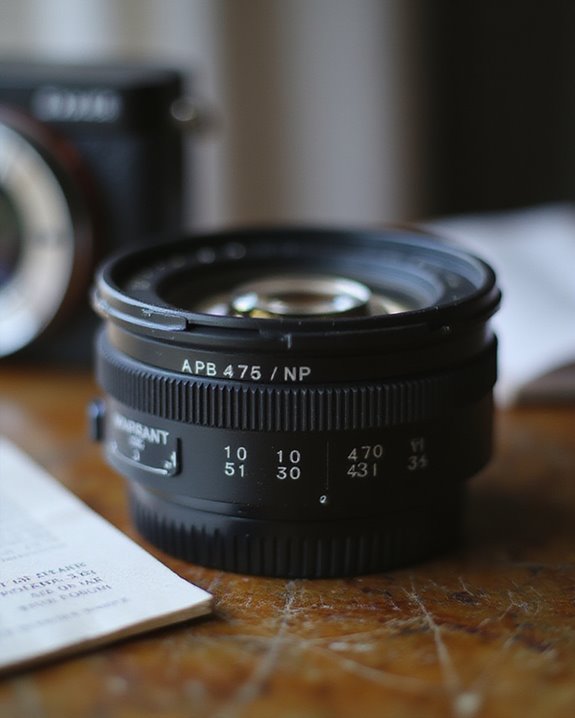
Exploring warranty options represents an essential aspect of lens purchasing decisions that photographers often overlook until mechanical issues arise. Standard manufacturer warranties, like Nikon’s five-year coverage in the USA, provide protection against defects, while extended options such as Canon CarePAK PLUS offer additional benefits including accidental damage protection. When evaluating warranty plans, consumers should carefully examine Warranty Exclusions, which may omit coverage for misuse, unauthorized repairs, or environmental damage, potentially compromising protection when most needed.
Firmware Compatibility issues can emerge during product lifespans, with many manufacturers updating products during warranty service. Plans like Mack Warranty ($274) and Canon CarePAK PLUS ($135.99) differ substantially in cost and coverage, making comparison essential. Photographers should consider warranty transferability for future resale value, warranty duration relative to expected lens lifespan, and whether protection against normal wear justifies the additional expense.
Seasonal Sales and When to Buy for Maximum Savings

Strategic timing can dramatically impact photographers’ budgets when purchasing camera lenses, with price fluctuations following predictable seasonal patterns throughout the year. Major retailers like Best Buy, Samy’s Camera, and Camera Wholesalers offer substantial discounts during Black Friday, Christmas, and end-of-year clearance events, when inventory management concerns trigger Flash Sales with savings of 15-30%. Summer sales and manufacturer rebates present additional opportunities for cost-conscious buyers seeking quality optics.
Economic Factors influence retailer pricing strategies, particularly during trade shows and holiday shopping periods when competition intensifies. Photographers can maximize savings by comparing prices across platforms, utilizing discount codes, considering open-box options, and subscribing to retailer newsletters for advance notice of promotions. Bundle packages that include complementary accessories often represent superior value propositions for equipment investments.
Trade-In Programs to Offset Your New Lens Purchase

Camera enthusiasts looking to upgrade their equipment often face the financial challenge of purchasing new lenses, but trade-in programs offer a practical solution to offset these costs while responsibly managing existing gear. Major retailers including Adorama, MPB, B&H, KEH, and Henry’s provide structured trade-in options with varying benefits and processes. Most programs offer free shipping labels, online quotes, and multiple payout options, with potential bonuses like KEH’s 10% credit increase when trading toward new purchases. These services provide positive environmental effects by extending equipment lifecycles and reducing electronic waste through refurbishment. Photographers should consider tax strategies when selecting payout methods, as cash transactions may have reporting requirements that store credit options don’t trigger. Professional evaluation services eliminate the risks associated with private sales while expediting the upgrade process.
Frequently Asked Questions
How Do I Test a Lens Before Purchasing Online?
Lens testing requires requesting sample images and videos showing functionality at various apertures. Buyers should verify seller history, demand return policies, and consult online reviews documenting performance characteristics before committing to purchase.
Can I Rent Lenses Before Committing to a Purchase?
Photographers can dip their toes in the optical ocean through lens rentals before taking the plunge. Rental benefits include risk-free testing, while seasonal options provide flexibility for specialized projects without long-term financial commitment.
Are Gray Market Lenses Worth the Savings?
Gray market lenses offer significant savings but carry warranty risks. Purchasers should weigh potential service limitations against cost benefits, while also considering ethical concerns regarding unauthorized distribution channels before making their decision.
How Often Should Professional Photographers Replace Their Lenses?
Like ancient trees in a forest, quality lenses endure for decades. Professionals typically replace equipment when performance declines or technology advances substantially—not by calendar. Lens longevity depends on care, while upgrade timing follows functional necessity.
What Insurance Options Exist for Protecting Expensive Lens Investments?
Photographers can protect expensive lenses through specialized lens insurance from dedicated camera insurers or policy types like scheduled personal property riders on homeowners/renters insurance. Each offers varying coverage levels for theft, damage, and liability.


